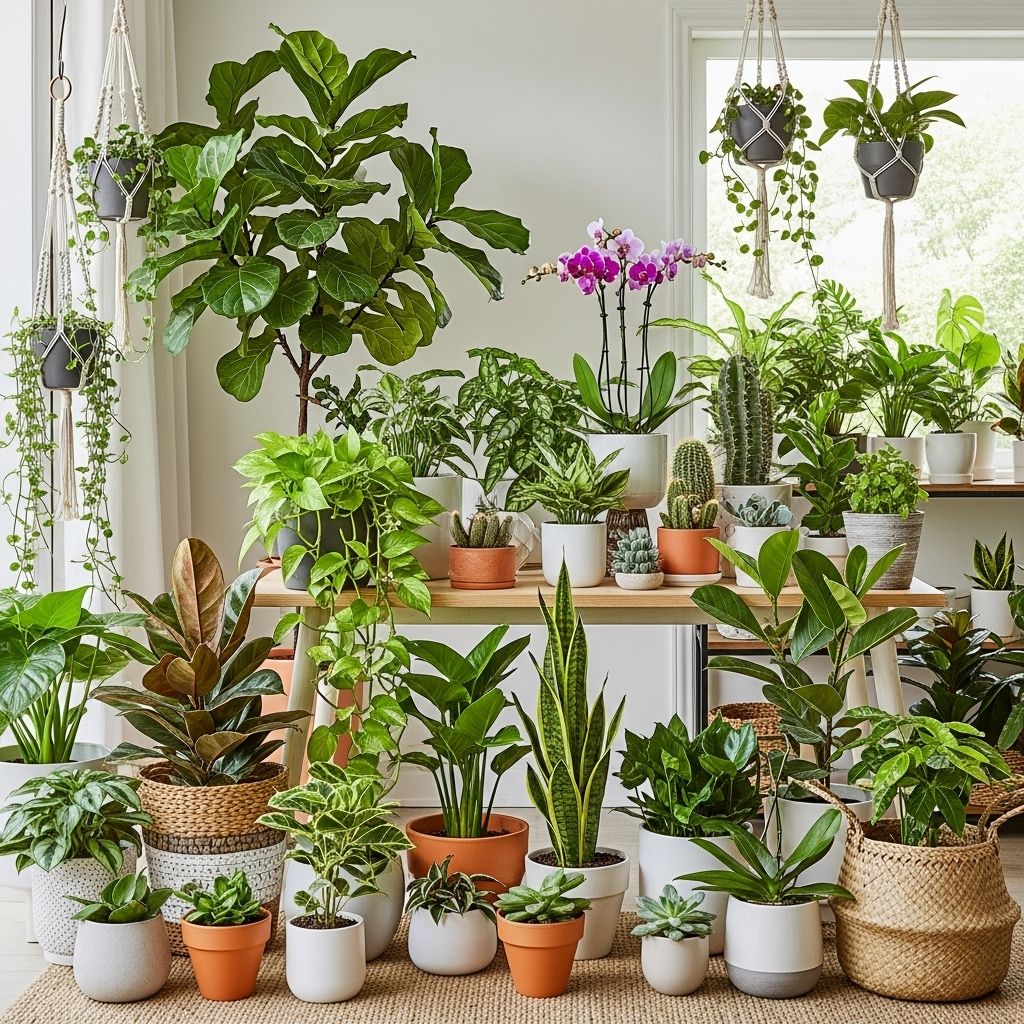43 Most Common Houseplants: Care, Tips, and Identification
Equip yourself with straightforward upkeep advice for every green companion in your home.

Image: HearthJunction Design Team
Indoor gardening offers a rewarding escape within your own home, filling living spaces with beauty, cleaner air, and personal satisfaction. With a huge variety of textures, colors, and care requirements, choosing the right common houseplants can seem overwhelming. This comprehensive guide shines a light on 43 of the most frequently seen indoor plants, explaining their care needs, unique characteristics, and why they are favorites for beginner and experienced plant parents alike.
Table of Contents
- Asparagus Fern
- Banana Plant
- Begonia
- Norfolk Island Pine
- General Houseplant Care Tips
- Frequently Asked Questions
Introduction: Why Houseplants Matter
Houseplants do more than look good—they improve indoor air quality, boost humidity, and may even reduce stress levels. Finding the right plant for your light, climate, and lifestyle will ensure a harmonious and thriving indoor garden.
Quick Reference Comparison Table
| Plant Name | Light Needs | Watering | Skill Level | Pet Safe? |
|---|---|---|---|---|
| Asparagus Fern | Indirect | Frequent, gentle | Beginner | No |
| Banana Plant | Bright | Keep moist | Intermediate | Yes |
| Begonia | Bright, indirect | Regular | Intermediate | Varies |
| Norfolk Island Pine | Medium to bright | Let dry between | Beginner | Yes |
Asparagus Fern
Asparagus Fern (not a true fern) is a lush, bushy South African native valued for its fine texture and low-fuss nature. It features arching stems filled with tiny, soft leaves.
- Care Level: Beginner-friendly
- Light: Prefers indirect light
- Water: Gentle, frequent watering; avoid letting the soil dry out completely
- Potting: Needs sturdy containers as roots are strong
- Toxicity: Toxic to pets and humans if ingested
Prune older or yellowing stems to keep it tidy, and repot every two years to manage root growth.
Banana Plant
The Banana Plant, often mistaken for a tree, is actually a giant herb. Indoors, its wide, glossy leaves bring a tropical vibe to any room.
- Care Level: Intermediate; requires more attention
- Light: Needs very bright light
- Water: Keep soil consistently moist, but not soggy
- Notes: Indoor plants are for foliage; unlikely to fruit indoors
Provide extra humidity and fertilize during the growing season for the healthiest leaf production.
Begonia
Begonias are cherished for their vibrant flowers and dramatic foliage. With hundreds of hybrids available, their care may feel daunting for beginners.
- Care Level: Intermediate
- Light: Bright, indirect sunlight
- Water: Regular watering; prefers higher humidity
- Pruning: Essential for strong blooming
- Toxicity: Varies by species
Remove dead flowers and leaves frequently to maintain a full habit and encourage new blooms.
Norfolk Island Pine
This compact “pine” tree provides a bit of the forest indoors. Norfolk Island Pines can reach dramatic heights outdoors, but indoors stay reasonably sized.
- Care Level: Beginner
- Light: Medium to bright filtered light
- Water: Allow soil to dry fully between waterings (about every 1–2 weeks)
- Soil: Prefers acidic potting mix
Rotate the pot regularly to promote even growth. These trees can survive brief spells of neglect.
Additional Popular Houseplants
- Pothos: A vining, highly adaptable plant with heart-shaped leaves, thrives in low to bright light and tolerates infrequent watering.
- Snake Plant (Sansevieria): Famous for its upright, swordlike leaves and near-indestructible temperament. Prefers indirect light, tolerates low humidity, and infrequent watering.
- Spider Plant: Recognized for curly, variegated leaves and baby “plantlets.” Needs indirect light and evenly moist soil.
- ZZ Plant: An attractive houseplant with thick, waxy leaves that tolerates very low light and drought.
- Peace Lily: Prized for its white flowers and lush green foliage; prefers shady spots and consistently damp soil.
- Philodendron: A broad group of vining and upright plants, forgiving of most care mistakes and thriving in medium light.
- Aloe Vera: Succulent with upright, fleshy leaves; needs very bright light and sparse watering.
- Fiddle Leaf Fig: Known for large, sculptural leaves; must have bright, indirect light and careful watering.
- Monstera Deliciosa: The “Swiss Cheese Plant” with iconic split leaves, favoring ample light and routine moisture.
- Rubber Plant: Robust, shiny leaves, adapts to different light levels, but prefers bright, indirect sun.
- Jade Plant: A classic succulent for beginners, craving full sun and little water.
Note: This is not an exhaustive list of all 43, but these species represent the most sought-after and forgiving plants, covering various sizes, shapes, and colors for different spaces and plant caretakers.
General Houseplant Care Tips
While individual requirements vary, most houseplants thrive when you pay attention to these general principles:
- Light: Most houseplants prefer bright, indirect sunlight. Avoid hot direct sun, which can scorch leaves. Observe your plant and adjust location if it seems stressed.
- Water: Overwatering is a common mistake. Test soil moisture before watering. Many tropicals appreciate higher humidity, while succulents require drier conditions.
- Soil: Use a quality potting mix, and consider adding perlite or similar to boost aeration. Worm castings can add nutrients for robust growth.
- Humidity: For plants craving humidity, a pebble tray or humidifier works better than misting alone. Grouping plants together can also help.
- Repotting: Check for roots escaping out of pots. Repot every 1-2 years or when growth stalls.
- Fertilizing: Most houseplants need occasional feeding, especially in spring and summer.
- Pruning: Remove damaged, yellowing, or old leaves frequently to encourage healthy new growth.
- Pest Monitoring: Inspect regularly for pests. Isolate new plants until you’re confident they’re pest-free.
Houseplant Selection Tips
- Assess the lighting in each room before buying a plant
- Check pet safety by researching plant toxicity
- Consider your maintenance commitment—succulents and ZZ plants are fine for forgetful waterers
- Mix textures and heights for visual interest
Troubleshooting Common Issues
- Yellowing leaves: Often a sign of excess watering or inadequate drainage
- Leggy growth: Increase light levels
- Wilting: Inspect roots and potting mix—could be too dry or too wet
- Pest signs: Look for sticky residue, webs, or unusual spots on leaves
- Brown leaf tips: Usually from low humidity or fertilizer buildup
Frequently Asked Questions (FAQs)
Q: What is the easiest houseplant for beginners?
A: Snake Plant or Pothos—they handle irregular watering and low light with ease.
Q: Why are my leaves turning yellow?
A: Yellowing is often from overwatering, poor drainage, or a nutrient deficiency. Check soil and adjust care accordingly.
Q: How do I increase humidity for my plants?
A: Group plants together or use a humidifier. Pebble trays help, but misting alone is often ineffective for raising overall humidity significantly.
Q: What’s the best light for most houseplants?
A: Bright, indirect light is ideal, though some will adapt to low-light spots (such as ZZ Plant and Snake Plant).
Q: Should I fertilize my plants year-round?
A: Only fertilize during the active growing season (typically spring and summer); most plants are dormant over winter and require less feeding.
Q: Are houseplants safe for pets?
A: Some, like Spider Plant and Areca Palm, are pet-safe, but others (e.g., Asparagus Fern, Dieffenbachia, Philodendron) can be toxic. Always check before purchase.
Q: How often do I repot houseplants?
A: Every 1-2 years, or sooner if roots become visible at the surface or poke through drainage holes.
Final Thoughts
Whether you’re just beginning your houseplant journey or expanding a lush indoor collection, it pays to understand the preferences of each species. With observation, patience, and a little trial and error, you’ll find the perfect green companions for every corner of your home. Use this guide as a starting point to explore the incredible world of common houseplants and cultivate your own indoor oasis.
References
Read full bio of medha deb












